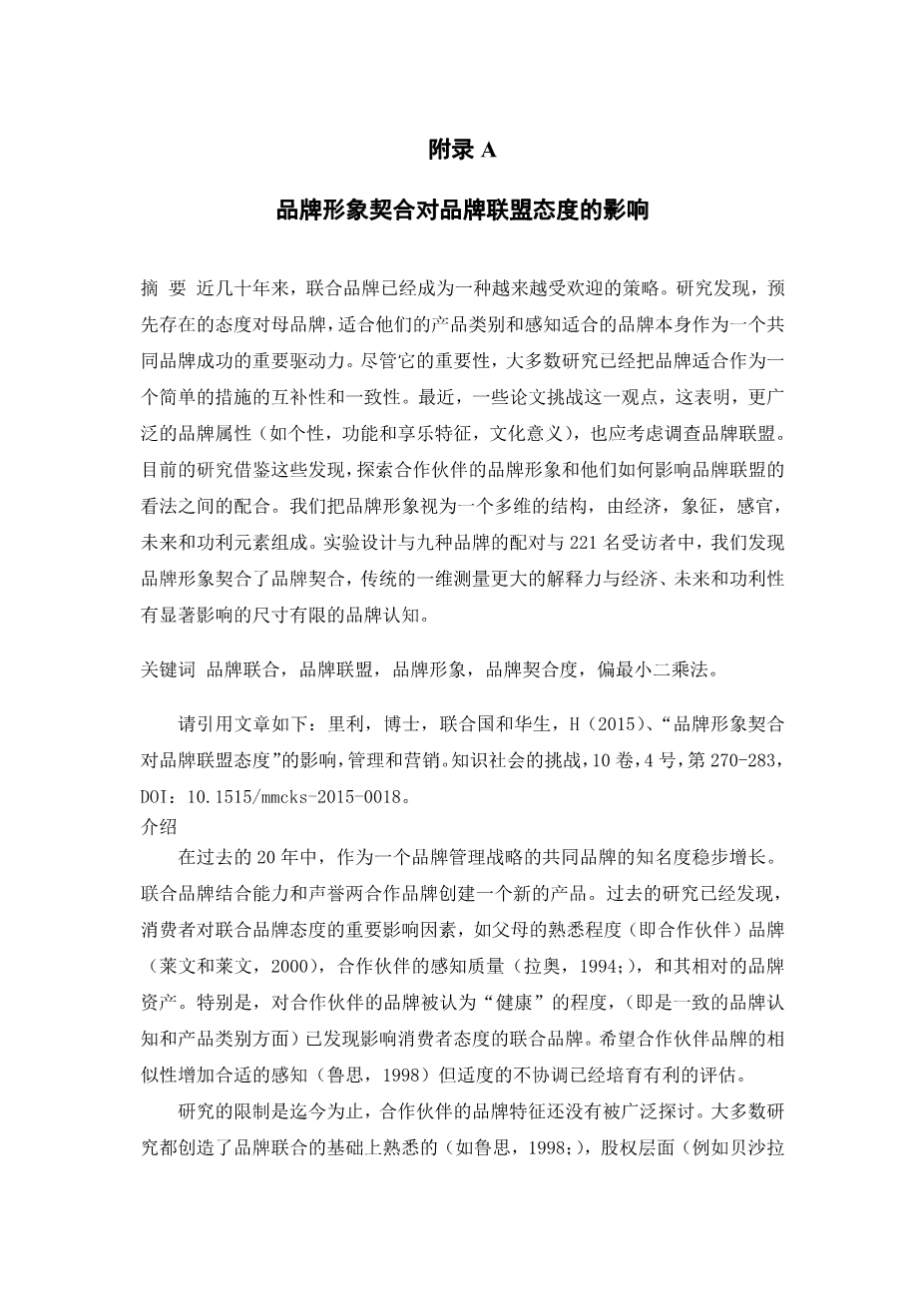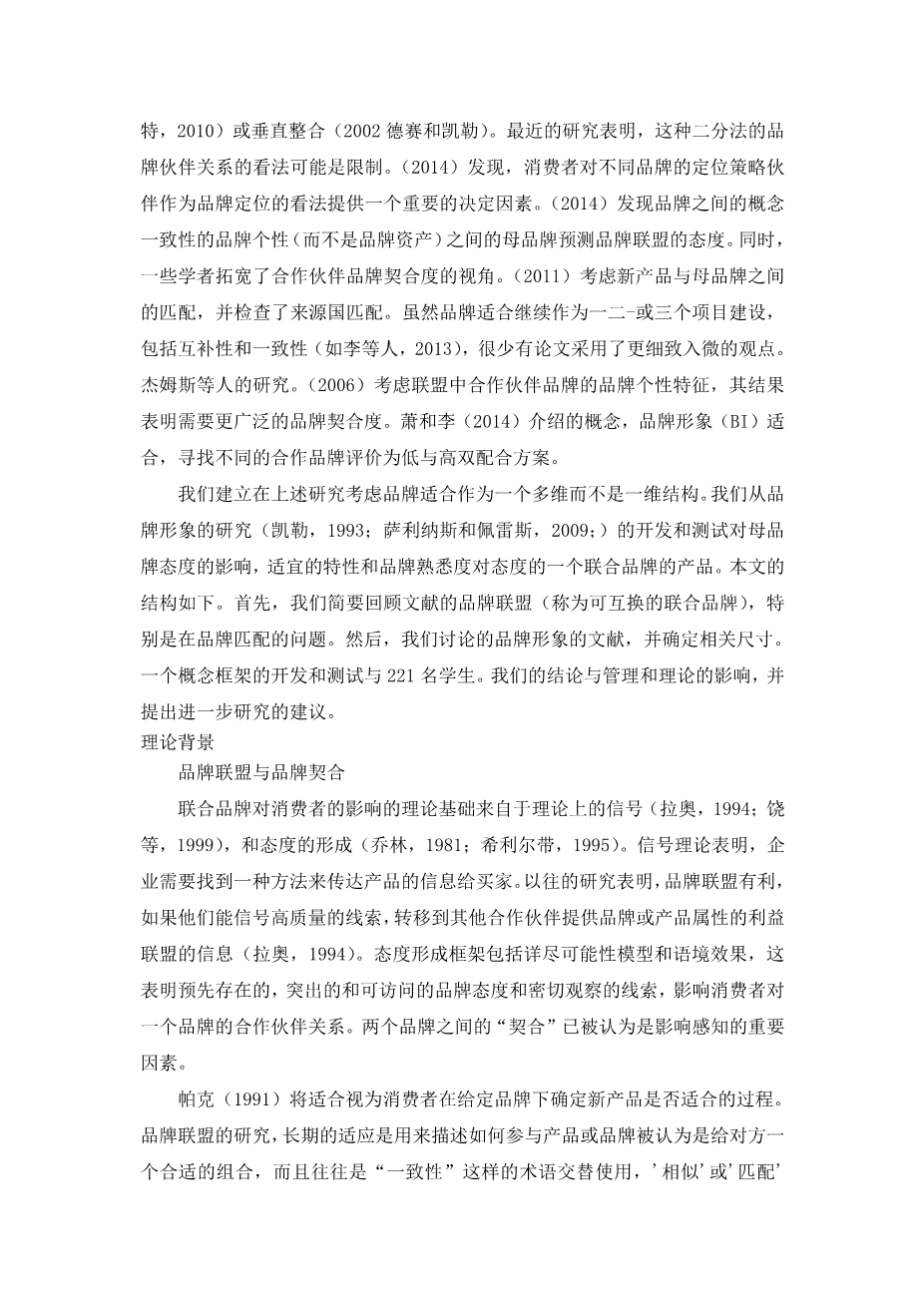The impact of brand image fit on attitude towards a brand alliance
Debra RILEY
Kingston University, Kingston-upon-Thames, UK
Nathalie CHARLTON
Kingston University, Kingston-upon-Thames, UK
Hillary WASON
Kingston University, Kingston-upon-Thames, UK
Abstract. Co-branding has become an increasingly popular strategy over recent decades. Studies have found that the pre-existing attitudes to the parent brands, fit between their product categories and perceived fit in the brands themselves as important drivers of a co-brand success. Despite its importance, most studies have treated brand fit as a simple measure of complementarity and consistency. Recently, a few papers have challenged this view, suggesting that a broader range of brand attributes (such as personality, functional and hedonic characteristics, cultural meaning) should also be considered when investigating brand alliances. The current study draws on these findings, exploring the fit between partnersrsquo; brand images and how they influence perceptions of a brand alliance. We treat brand image as a multi-dimensional construct, consisting of economic, symbolic, sensory, futuristic and utilitarian elements. Using an experimental design with nine hypothetical brand pairings with 221 respondents, we find brand image fit provides greater explanatory power over a traditional unidimensional measure of brand fit, with economic, futuristic and utilitarian dimensions having a significant influence on co-brand perceptions.
Keywords: co-branding, brand alliance, brand image, brand fit, partial-least squares.
Please cite the article as follows: Riley, D., Charlton, N. and Wason, H. (2015), “The Impact of Brand Image Fit on Attitude towards a Brand Alliance”, Management amp; Marketing. Challenges for the Knowledge Society, Vol. 10, No. 4, pp. 270-283, DOI: 10.1515/mmcks-2015-0018.
Introduction
The popularity of co-branding as a brand management strategy has grown steadily over the past 20 years. Co-branding combines the competencies and reputations of two partnering brands to create a new product (e.g. Park et al., 1996; Faems et al., 2005). Past research has identified important determinants of consumer attitudes to cobrands, such as familiarity with the parent (i.e. partner) brands (Levin and Levin, 2000), the perceived quality of the partners (Rao and Ruekert, 1994; Rao et al., 1999), and their relative brand equity (Washburn et al., 2000). In particular, the extent to which partner brands are perceived to lsquo;fitrsquo;, (i.e. be congruent in terms of brand perceptions and product categories) has been found to influence consumer attitudes to the co-brand (Baumgarth, 2004; Helmig et al., 2007; Lafferty et al., 2004; Simonin and Ruth, 1998). One would expect the similarity between partner brand to increase the fit perception (Simonin and Ruth, 1998) but moderate incongruity has been seen to foster favourable evaluations as well (Meyers-Levy and Tybout, 1989).
Unauthenticated
Download Date | 5/17/17 11:14 AM
Correspondence: Riley Debra d.riley@kingston
.ac.uk
A limitation of research to date is that partner brand characteristics have not been widely explored. Most studies have created co-brands based on familiarity (e.g. Simonin and Ruth, 1998; Baumgarth, 2004), equity levels (e.g. Washburn et al., 2000, 2004; Besharat, 2010) or vertical integration (Desai and Keller, 2002). Recent research suggests this dichotomous view of brand partnerships may be limiting. Singh et al. (2014) found consumer perceptions of the varying positioning strategies of partner brands to be a significant determinant of the positioning perceptions of the cobrand offering. Van der Lans et al. (2014) found that conceptual coherence in brand personality profiles (rather than brand equity) between parent brands predicts attitudes toward a brand alliance. In tandem, a few scholars are broadening the perspective of fit between partner brands. For instance, Bouten et al. (2011) considered the match between the new product and parent brand, and also examined the country of origin fit (Bluemelhuber et al., 2007; Lee et al. 2013). Although brand fit continues to be operational as a two- or three-item construct including complementarity and consistency (e.g. Lee et al., 2013), few papers have adopted a more nuanced view. A study by James et al. (2006) considered brand personality traits of partner brands in an alliance; their results suggest that a broader notion of brand fit is needed. Xiao and Lee (2014) introduce the concept of brand identity (BI) fit, finding different co-brand evaluations for low versus high BI fit scenarios.
We build on the above research to consider brand fit as a multi-dimensional rather than a unidimensional construct. We draw on brand image research (Keller, 1993; Romaniuk et al., 2012; Salinas and Perez, 2009; Hsieh and Lindridge, 2005) to develop and test the impact of attitudes toward the parent brands, fit characteristics and brand familiarity on attitudes towards a co-branded product. The paper is organized as follows. First we briefly review the literature on brand alliances (referred to interchangeably as co-branding), looking specifically at issues of brand fit. We then discuss the brand image literature and identify relevant dimensions. A conceptual framework is developed and tested with 221 students. We conclude with managerial and theoretical implications, and suggestions for further research.
MMCKS
271
Theoretical background
Brand alliance and brand fit
The theoretical foundations of co-brandinglsquo;s impact on consumers come from theories on sig
剩余内容已隐藏,支付完成后下载完整资料


英语译文共 6 页,剩余内容已隐藏,支付完成后下载完整资料
资料编号:[613361],资料为PDF文档或Word文档,PDF文档可免费转换为Word
课题毕业论文、文献综述、任务书、外文翻译、程序设计、图纸设计等资料可联系客服协助查找。


